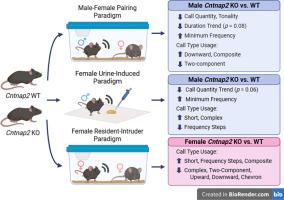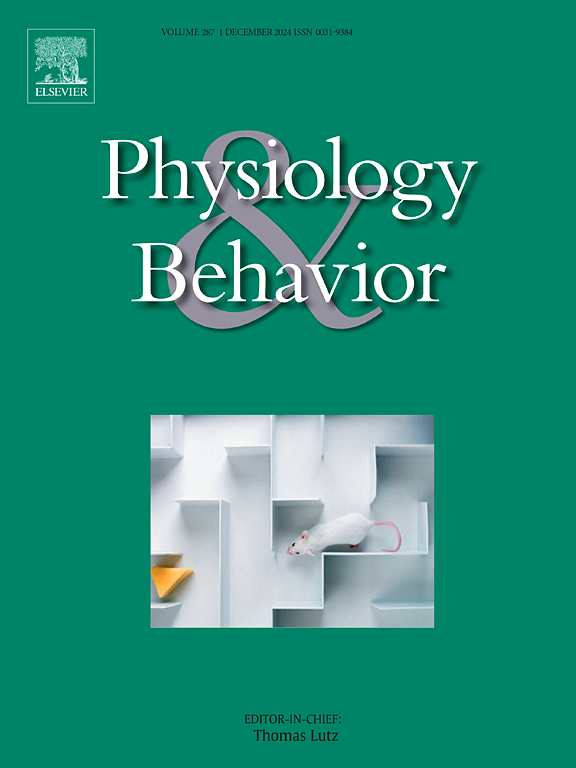Cntnap2敲除小鼠成年超声发声的综合分析揭示了定量、定性和性别特异性差异。
IF 2.5
3区 医学
Q2 BEHAVIORAL SCIENCES
引用次数: 0
摘要
交流缺陷是自闭症谱系障碍(ASD)的一个核心特征,出现于发育早期并持续到成年。大多数研究只关注早期生活交际,因此成人交际行为的机制尚不清楚。Cntnap2基因与ASD缺陷的发病有关,对声音交流行为特别重要,然而,它对成人交流的影响尚不清楚。为了解决这个问题,我们评估了Cntnap2野生型(WT)和敲除型(KO)成年小鼠的声音交流行为,即超声波发声(usv),以及气味标记行为——一种非声音交流形式。当通过雄性-雌性配对过程评估求爱usv时,我们发现KO雄性比WT雄性产生更少的usv,持续时间更短,音调更高,音调更低。它们发出的双组分调用类型也更少,而发出的下行和复合调用类型更多。在雌性尿液诱导的交流范式中,我们发现与对照组相比,KO雄性倾向于降低呼叫率,产生更复杂和更短的呼叫类型,但频率更低。没有发现usv的其他变化,也没有发现两组之间气味标记行为的差异。最后,使用女性居民-入侵者范式,我们发现呼叫类型利用发生了许多变化,但呼叫率和呼叫的频谱和时间特征没有变化。总之,这些发现表明Cntnap2基因选择性地改变了成人的声音交流行为。本文章由计算机程序翻译,如有差异,请以英文原文为准。

A comprehensive analysis of adult ultrasonic vocalizations in Cntnap2 knockout mice reveals quantitative, qualitative, and sex-specific differences
Communicative deficits are a core feature of autism spectrum disorder (ASD) that present early in development and persist into adulthood. The majority of studies focus exclusively on early life communication, therefore the mechanisms underlying adult communicative behaviors are unclear. The Cntnap2 gene is implicated in the onset of ASD deficits and is specifically vital for vocal communicative behaviors, however, its effects on adult communication are not known. To address this problem, we assessed vocal communicative behaviors known as ultrasonic vocalizations (USVs) in Cntnap2 wildtype (WT) and knockout (KO) adult mice as well as scent marking behaviors - a form of non-vocal communication. When assessing courtship USVs via a male-female pairing session, we found that KO males produced significantly fewer USVs with a shorter duration, higher pitch, and lower tonality than WT males. They also emitted fewer two-component call types and more downward and composite calls. In the female urine-induced communicative paradigm, we found that KO males emitted calls of a higher frequency, trended towards a decreased call rate, and produced significantly more complex and short call types but less frequency step calls relative to controls. No other changes in USVs were found nor were there any differences in scent marking behaviors between groups. Lastly, using the female resident-intruder paradigm, we found numerous changes in call type utilization, but no differences in the call rate nor the spectral and temporal features of the calls. Altogether, these findings indicate that the Cntnap2 gene selectively alters adult vocal communicative behaviors.
求助全文
通过发布文献求助,成功后即可免费获取论文全文。
去求助
来源期刊

Physiology & Behavior
医学-行为科学
CiteScore
5.70
自引率
3.40%
发文量
274
审稿时长
47 days
期刊介绍:
Physiology & Behavior is aimed at the causal physiological mechanisms of behavior and its modulation by environmental factors. The journal invites original reports in the broad area of behavioral and cognitive neuroscience, in which at least one variable is physiological and the primary emphasis and theoretical context are behavioral. The range of subjects includes behavioral neuroendocrinology, psychoneuroimmunology, learning and memory, ingestion, social behavior, and studies related to the mechanisms of psychopathology. Contemporary reviews and theoretical articles are welcomed and the Editors invite such proposals from interested authors.
 求助内容:
求助内容: 应助结果提醒方式:
应助结果提醒方式:


